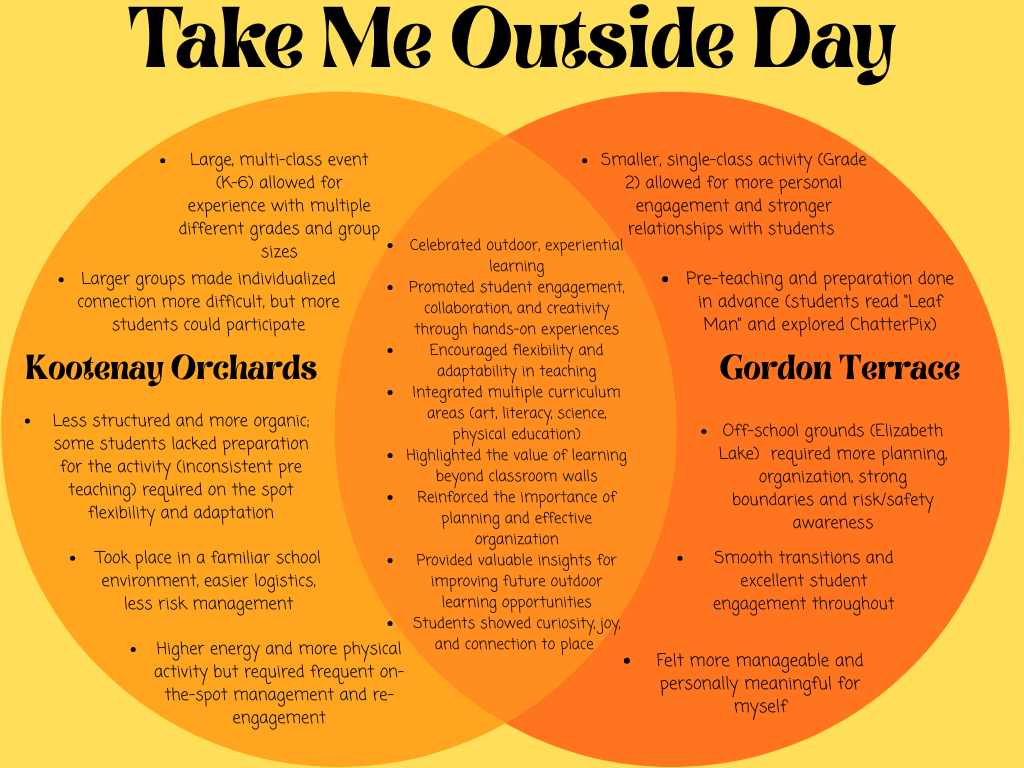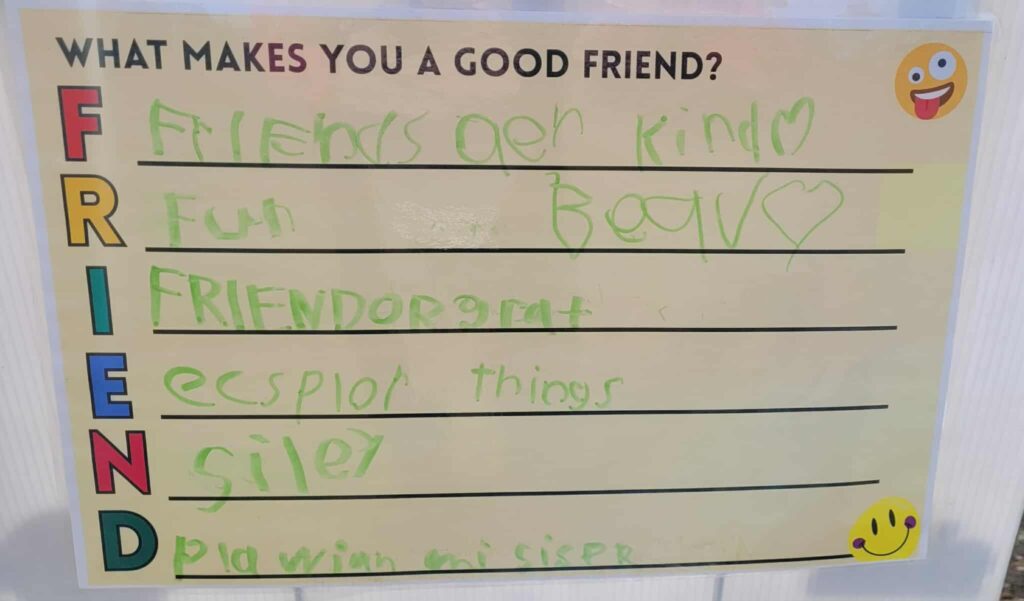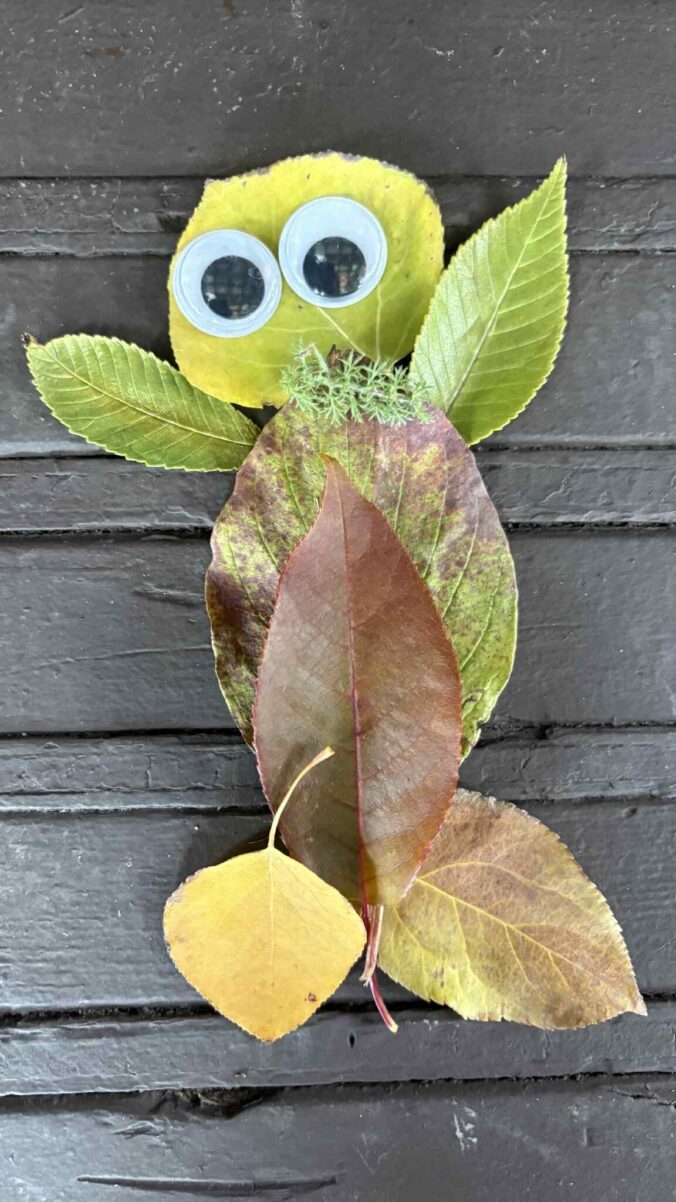Reflection 6: Take Me Outside Day at Kootenay Orchards and Gordon Terrace
Take Me Outside Day was such a fun and rewarding learning experience. Having the opportunity to take part in two different types of TMO activities, across two schools with varying class sizes, made it an especially meaningful first experience for me. I really enjoyed being outdoors with the students on both days, and I came away with so many valuable insights, lessons, and ideas to build on for next year. Learning outdoors is such an engaging, creative, and fun way to connect with students. It allows for deeper understanding through hands-on experiences and encourages curiosity in ways that a traditional classroom sometimes can’t. Take Me Outside Day reminded me how powerful outdoor learning can be, not just for students, but for educators too. It’s an opportunity to explore new ways of teaching, to learn alongside our students, and honestly, to simply enjoy being outside in the fresh air and sunshine.

“Bucket Buddies” at Kootenay Orchards
Our first Take Me Outside Day in-situ experience took place at Kootenay Orchards, where we led an “I Love a Challenge” themed activity connected to a story walk for “The OK Book” by Amy Krause Rosenthal. There were eight teacher candidate groups in total spread out across the schoolyard and each group presented an activity at different levels: Kindergarten – grade 1 (Level 1), Grades 2–3 (Level 2), and Grades 4–6 (Level 3). Our activity was called “Bucket Buddies.” The main question guiding our station was “At KO, how can we toss to our buddies?” To tie in literacy, students also created acrostic poems for the words BUDDY and FRIEND, responding to the prompt “What makes a good buddy or friend?” Alongside this, we mainly focused on playing a bucket toss game using tennis and circus balls, encouraging teamwork, coordination and creative collaboration.

Working with Kindergarten students was definitely our biggest challenge of the day. We had a pair of very shy and very reserved students, and we quickly realized we needed to adapt our plan. Early on, we also learned the importance of setting clear under hand throwing boundaries, especially after I was unexpectedly beaned in the face by a frustrated, (surprisingly strong overhand throwing) kindergartener! Despite the kind of rough start, we did our best to pivot and make the activity fun and accessible for them. It wasn’t as successful as with our other groups, but it was a valuable learning experience.
As the Grade 2–3 groups arrived, we took a more flexible approach by offering direction but allowing students to explore and create their own versions of tossing games. This adjustment worked well, and having one teacher per small group helped support their creativity and problem-solving. We started off with the basics and they quickly were able to come up with their own challenges as they got more comfortable and confident with us and the activity. The Grade 4–6 group was our largest and most energetic. It was definitely chaotic, but in the best way. Their enthusiasm led to some of the most thoughtful and creative tossing challenges and acrostic poems of the day. Watching them collaborate and build on each other’s ideas was a highlight for our team. Overall, the day reinforced for me just how crucial flexibility is in teaching. No matter how carefully you plan, things rarely go exactly as expected. Each group brought something different, and each challenge became a chance to adapt, reflect, and grow. Despite the surprises (and the occasional flying ball!), it was a great experience that reminded me how lively and variable outdoor learning can be.

Friends ARE kind, silly, brave, fun, and like to “ecsplore ” things

My favorites were “Friends are rad, Friends are including and Friends do cool stuff” Heck ya!

“Leaf Man” activity and scavenger hunt at Gordon Terrace
Wow—our Take Me Outside Day with Gordon Terrace was absolutely wonderful! We worked with a Grade 2 class, and this time the activity was smaller and more structured than our previous experience. The class had spent the week preparing by reading “Leaf Man” by Lois Ehlert and exploring the app ChatterPix, so when we arrived, everything flowed seamlessly.


We worked in pairs of teacher candidates, each with two to three students, which made for a really fun and manageable group dynamic. The walk to and from Elizabeth Lake was such a highlight, the students were full of energy, singing songs, asking questions, and connecting with us in such a natural and joyful way. Our group of two students worked really well together, they listened, collaborated thoughtfully, and stayed engaged throughout the activity. We began with a nature-themed scavenger hunt for about 15 minutes, which tied in nicely with cross-curricular learning objectives and encouraged observation, curiosity, and creativity. After the scavenger hunt, we transitioned into our Leaf Man activity, where students created their own “leaf people.” This was such a hit! The students loved using natural materials, and the addition of googly eyes made their creations even more adorable and imaginative. Back in the classroom, we moved into the ChatterPix portion of the lesson. We helped students upload photos of their leaf people and animate them, recording short messages about “what the best part of outdoor learning was” for them. Finally, we uploaded their projects to Seesaw so parents could see their child’s work from our class. Overall, it was an incredibly positive experience. The smaller class size, thoughtful teacher preparation, and clear structure made everything run smoothly. I loved the balance of creativity, movement, and reflection, and the one-on-one time with students made it even more meaningful. This was such a memorable lesson, and one I’ll definitely be repeating with my future students!
On and Off-School-Ground Activities: Pros and Cons
Having the opportunity to participate in both on-school-ground and off-school-ground activities for Take Me Outside Day gave me helpful insight into how each type of experience operates and what each has to offer. Being on school grounds required less planning and paperwork (not that we were directly responsible for that part!) and made it easier to involve multiple classes and have much larger groups of students participate. It was a familiar environment for students, so they were more comfortable and didn’t require as much risk management and supervision. In contrast, our walking field trip to Elizabeth Lake needed much more preparation, organization, risk management and logistical planning to run smoothly (again not from us but from admin thank-you!!). I personally preferred the smaller class size and structured activity format of the walking field trip and leaf man activity. It allowed for more personal engagement and stronger connections with the students, and it felt more manageable for me. Students being in a new environment sparked a ton of curiosity and discovery. It felt like it allowed for more exploration and place-based learning. That being said, with a few adjustments and a bit more structure, I think the larger Kootenay Orchards activity day could be just as manageable if it was a little more organized. But due to circumstances beyond our (or our instructors’) control the classes were not as prepared or as clear on what our activity entailed. Having each class read ‘The OK Book” a few times beforehand and watch a few “I love a challenge” videos would have helped things connect for the students and prepare them for the day. As well as having a pre-determined and clear layout so each station was clearly identifiable, (ex. station 1-8 in numerical order) it would have helped the chaos factor. It would have helped us be a little more prepared, and the KO students and teachers have more direction, but overall it worked out well regardless and the kids had a ton of fun! Also, as much as I loved our poem activity, I think students were feeling bummed out they didn’t get to cycle through all the stations, so maybe if the poem was eliminated, or the final station was just a literacy station then they would have had more time to check out more activities. I am not sure how that would work in our short time frame, but in an ideal world they would have been able to participate in a few more stations.
Final Thoughts:
Learning outdoors is truly the best. For both days’ students showed increased engagement, collaboration, and interest through hands-on and physical experiences. The outdoor setting encouraged active learning, and it certainly added more fun. However, some challenges arose, such as needing to adjust our plan right away, managing distractions, maintaining focus, and ensuring safety in an open environment (more so for Elizabeth lakes). Despite these complexities, the activities naturally created cross-curricular experiences, pulling from subjects such as science, art, language arts, and physical health education. This allowed students to apply a variety of educational skills in real-world contexts and develop a stronger appreciation for their surroundings (without them even realizing, teaching win!) I think us as educators can take these outdoor learning experiences to spark new ideas for future projects and inspire more opportunities to learn outside throughout the year. Whether it’s a nature walk, a seasonal art project, or a science exploration in the schoolyard, each experience can help students see learning as something that happens everywhere. Most importantly, outdoor learning changes how we think, it encourages curiosity, creativity, and connection to the land that is carried back into the classroom. Take Me Outside Day can be so much more than a single event; it can be the starting point for a school culture shift that learning extends far beyond the classroom, reminding us all that some of the best lessons happen when we step outside.
Thanks Scott and Allie for organizing, arranging and providing us with these most excellent learning opportunities. :)


Leave a Reply
You must be logged in to post a comment.